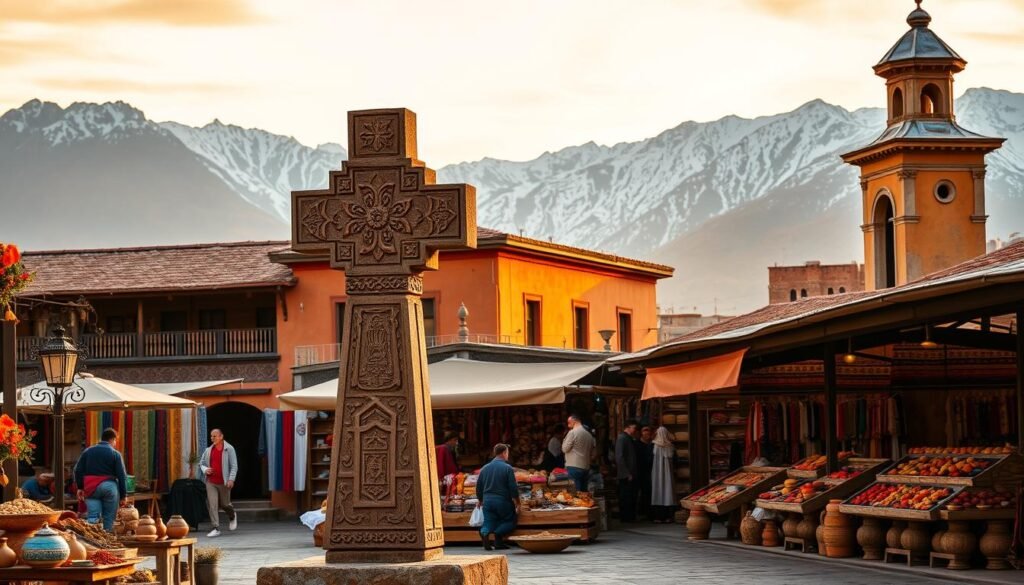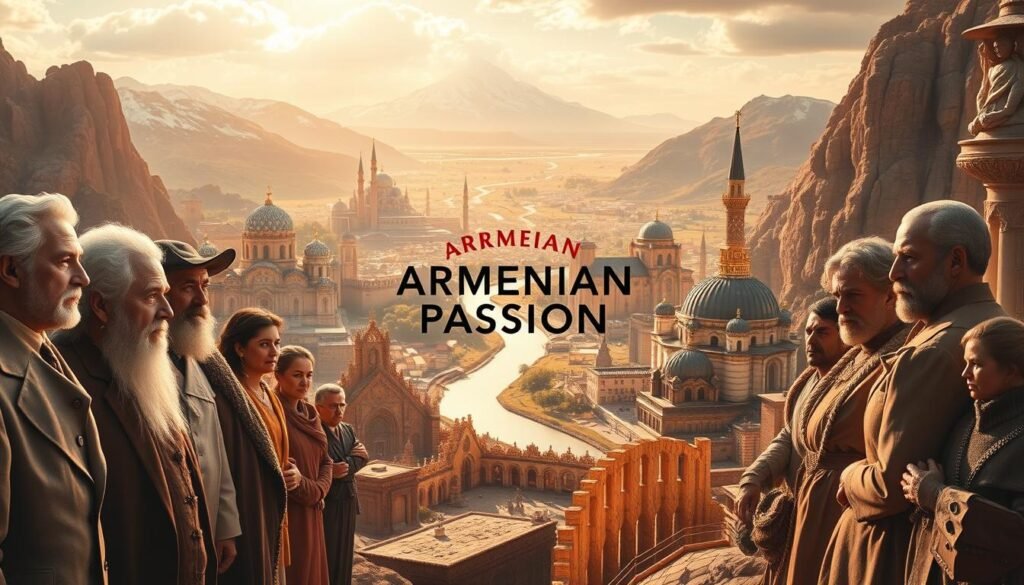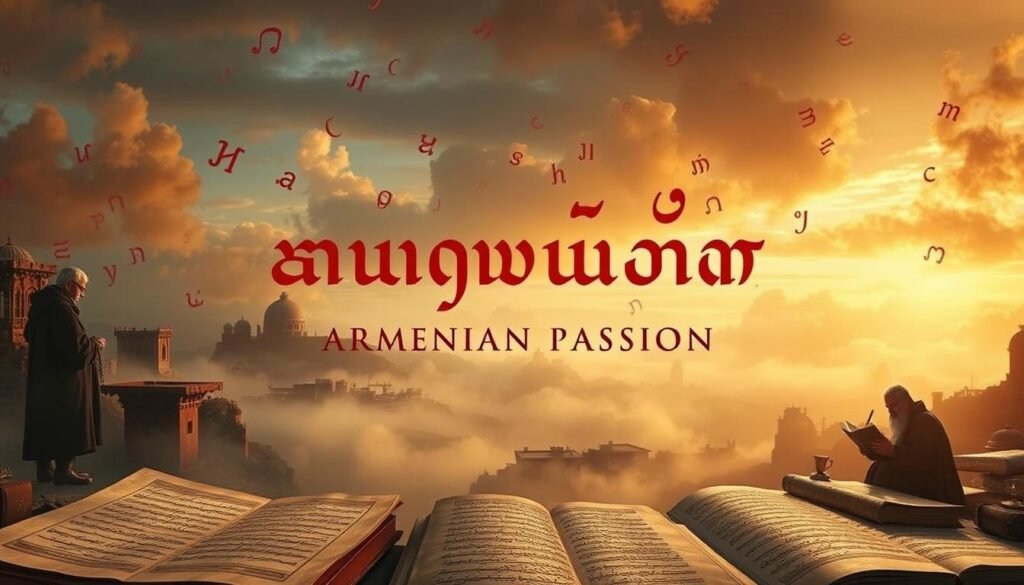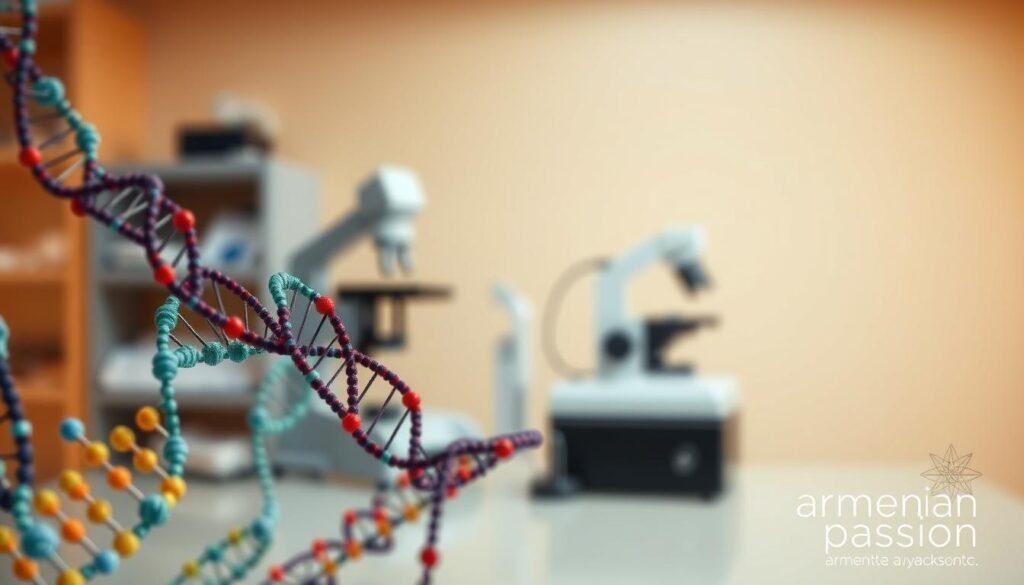What makes the Armenian race special? It’s not just about where they come from or their bloodline. It’s about their rich history, unique culture, and lasting traditions. Armenians have kept their heritage alive, shaped by survival, faith, and resilience.
The term “Armenian race” often raises questions. Is it about geography, language, or shared ancestry? Armenians blend Indo-European roots with a Caucasian geographic legacy. This mix has made them known for their artistic talent, strong Diaspora networks, and an ancient language.
At Armenian Passion, connecting with others who value Armenian heritage is important. Whether through music, food, or family pride, this dating site celebrates what unites Armenians worldwide. But how did these traditions evolve? The answers lie in exploring history, genetics, and cultural unity.
Key Takeaways
- Armenian identity combines race, ethnicity, and cultural practices passed through generations.
- Modern DNA studies reveal genetic ties linking Armenians to ancient Anatolian populations.
- Armenian culture includes unique contributions like the first Christian nation status (301 AD).
- Global Armenian communities maintain heritage through language, festivals, and family bonds.
- Discovering Armenian roots can deepen connections—both personally and through platforms like Armenian Passion.
What Race is Armenian Considered?
Armenian racial classification is a topic of interest in both scholarship and culture. Armenians are seen as an ethnic group with deep roots. Yet, their classification goes beyond simple racial labels. Today, discussions often revolve around Armenian ethnicity classification, blending language, geography, and culture.
Armenian Ethnic Classification
Armenians have a unique Armenian ethnicity classification based on shared history and language. Their identity defies narrow racial labels, focusing on heritage passed down through generations. Genetic and cultural ties unite communities worldwide, sparking debates on categorizing this ancient people.
Armenian Indo-European Origins
- The Armenian language is a branch of the Indo-European family, connecting it to Greek and Persian.
- Shared linguistic roots suggest ancestral migrations and cultural exchanges over millennia.
This heritage is part of the Armenian Indo-European origins, bridging Eastern and Western civilizations.
Caucasian Geographic Identity
Armenia sits at the crossroads of Europe and Asia, defining its Caucasian identity. The Caucasus region’s complex history has shaped traditions, art, and social structures. Diaspora communities keep these ties alive through food, festivals, and language.
Understanding these layers helps Armenians worldwide connect with their shared legacy. Heritage is more than bloodlines; it’s a living story told through each generation.
The Historical Origins of Armenian People
Armenian origins go back to the rugged Armenian Highland. This area shows a history of strength. The first states, like Hayasa-Azzi and Urartu, left a mark on Armenian ancestors.
These civilizations flourished in what is now eastern Turkey and Armenia. They shaped the Armenian culture.
- Hayasa-Azzi: A Bronze Age confederation near Lake Van, interacting with Hittite empires.
- Urartu: Known for its advanced irrigation systems and fortress networks, later evolving into the Armenian kingdoms.
Armenian ancestors built strong traditions despite challenges. Their stories are in stone carvings and oral tales. These stories show their deep connection to the Armenian homeland.
Today, these roots inspire Armenians everywhere. They explore their heritage through DNA tests or connecting with others on sites like Armenian Passion.
Learning about Armenian origins is more than history. It’s about honoring those who built cities like Tushpa and defended their land. Exploring these stories lets you feel the strong legacy of the Armenian people.
Armenian Genetic Heritage and DNA Studies
Modern Armenian genetic studies show how our genes carry ancient history. Researchers study Armenian DNA to uncover migration paths and cultural exchanges. These studies reveal a genetic legacy from the Caucasus, mixing Armenian haplogroups that show both regional and unique ancestral ties.
Recent Genetic Research Findings
Recent science shows Armenians have genetic ties to ancient Anatolia and the Caucasus. Studies using Armenian ancestral markers confirm connections to Bronze Age populations. This proves a 3,000-year genetic thread, challenging old views on migration and cultural shifts.
Distinctive Armenian Genetic Markers
Armenian genetics include unique markers like haplogroup J2a, tracing back to early farmers. Other haplogroups, like G2a, link to ancient Anatolian herders. These markers create a distinct profile, showing Armenians are different yet share histories with others.
Connections to Other Populations
Armenian genetic data reveals connections to Greeks, Kurds, and Georgians. Yet, it also shows a distinct Armenian DNA cluster. This balance reflects centuries of cultural exchange without losing unique identity—a theme explored in this analysis on race and heritage.
For those looking into their roots, platforms like Armenian Passion help connect with others. Understanding these bonds fosters global community, proving heritage lives on in every generation’s DNA.
Armenian Physical Characteristics and Traits
Armenian physical features show a mix of genetic diversity. Many have dark hair and eyes, with skin tones from fair to olive. Facial traits often include a straight or slightly hooked nose, known as the “Armenian bridge,” and high cheekbones.
- Dark hair and eyes: A hallmark of Armenian appearance
- Narrow facial structures with a defined nasal profile
- Medium to tall statures influenced by regional genetics
Armenian looks vary due to Armenia’s location between Europe and Asia. While some traits are common, cultural bonds unite Armenians more than physical markers. ArmenianPassion.com connects members through shared heritage, whether it’s facial characteristics or cultural ties. The platform offers verified profiles and event calendars for authentic connections.
Explore how Armenian phenotype traits and cultural values unite people at ArmenianPassion.com. Celebrate diversity and honor what unites Armenians worldwide.
The Ancient Armenian Kingdom and Its Legacy
The story of the Armenian kingdom goes back thousands of years. It started with the Urartu civilization and became the first Christianity-centric state. This legacy connects Armenians worldwide, shaping their culture.
Urartu and Pre-Christian Armenia
Before Ancient Armenia existed, the Urartu civilization flourished in mountain valleys. This early kingdom set the stage for governance and trade. It also shaped Armenian identity. Archaeologists have found fortresses and ancient texts, showing Urartu’s lasting influence on Armenian kingdom history.
The First Christian Nation
In 301 CE, Armenia became the world’s first Christianity-adopting nation under King Tiridates III. This choice created a spiritual legacy seen in places like Etchmiadzin Cathedral. Armenian Christianity is a key part of their cultural strength.
Historical Armenian Territories
From Lake Van to Artsakh, historic Armenian lands have changed over time. Key areas include:
- Urartu’s heartland in modern-day Turkey
- Medieval kingdoms in Cilicia
- Contemporary Armenia and Nagorno-Karabakh
These lands tell stories of survival. Today, Armenian Passion connects people to this heritage. Explore your shared roots at armenianpassion.com.
Armenian Cultural Identity Beyond Race
Armenian cultural identity is a living legacy of traditions passed through generations. From duduk melodies to intricately woven carpets, these practices anchor Armenian cultural heritage. Festivals like Vardavar, where red dye splashes symbolize renewal, or the gulash dance’s rhythmic steps, keep traditions alive for global Armenian communities.

Family traditions hold the heart of Armenian values. Grandparents teach grandchildren to knead lavash bread or recite epic poems like Sasoun. Even in distant lands, these rituals—like lighting candles at Vartanantz Day—reinforce Armenian family traditions as pillars of identity.
- Food: Meals like khorovats barbecues become cultural classrooms.
- Art: Miniature painting and stone carvings tell untold stories of survival.
- Music: The duduk’s mournful tones bridge ancient and modern Armenia.
Armenian cultural heritage also guides relationships. Armenian Passion (https://armenianpassion.com) helps users find partners who cherish these traditions. Shared values—from hospitality to communal feasts—create connections deeper than shared ancestry.
Through these customs, Armenian cultural identity remains a vibrant force. It’s not just history—it’s a living dialogue between past and present, uniting hearts across continents.
The Armenian Diaspora: A Global Community
The Armenian diaspora stretches across continents. Places like Glendale, California, and New York’s Little Armenia are full of life. These areas keep traditions alive while welcoming new generations.
Armenian-Americans stay connected through cultural events, language classes, and community centers. These efforts help maintain their heritage.
Armenian Communities in America
In the U.S., big Armenian communities celebrate with festivals like Vartanant. They enjoy dance, music, and food together. Schools teach Armenian history, keeping the language and customs alive.
Churches like St. Vartan Cathedral in Manhattan serve as spiritual homes. They provide a sense of belonging and tradition.
How Armenians Maintain Their Identity Abroad
- Language schools: Teaching Eastern and Western Armenian to children
- Annual cultural festivals showing off folk attire and crafts
- Charitable organizations funding heritage projects worldwide
Connecting with Armenian Roots on Armenian Passion
Platforms like Armenian dating site Armenian Passion help bridge gaps. Members share recipes, traditions, and find partners who value Armenian cultural preservation. Profiles often highlight family heritage or favorite Armenian sayings, creating meaningful connections.
“Finding someone who understands our history is key,” says a user from Boston. “Armenian Passion helps me stay rooted while building a future.”
Armenians worldwide are building a tapestry of resilience. Whether in Los Angeles or Lisbon, their stories keep traditions alive. They do this one recipe, festival, or online match at a time.
Armenian Language: A Distinct Indo-European Branch
The Armenian language history goes back over 1,600 years. It started with the Armenian alphabet in 405 CE. Mesrop Mashtots created this 39-character script, which is key to Armenian linguistic heritage.
This alphabet saved ancient texts, poetry, and religious works. It helped keep culture alive during long periods of being apart.
Today, there are two main dialects: Eastern Armenian and Western Armenian. Eastern Armenian is spoken in Armenia and Russia. Western Armenian is used by people in diaspora communities.
These dialects show the language’s history but share the same alphabet. For Armenian linguistic heritage, this is both a challenge and a way to connect.
“Language is the soul of a people,” says one proverb. This is very true for Armenians everywhere. They use dialects to keep traditions alive and connect through stories and sayings.
Armenian Passion is a site that connects Armenians worldwide. It supports both dialects. Members can talk in Eastern Armenian or Western Armenian. This helps build connections through shared phrases and jokes.
Whether talking about family recipes or cultural events, language is key. It helps us understand each other better.
The Armenian alphabet has lasted from medieval times to today. It’s a symbol of strength. Learning or speaking Armenian today keeps this legacy alive, in places like Yerevan, Beirut, or Los Angeles.
Famous Armenians Who Have Shaped History and Culture

From art to politics, famous Armenians have made a big impact worldwide. Their stories inspire many and show the lasting impact of Armenian historical figures and Armenian-American notables.
Armenian Contributions to Arts and Entertainment
- Charles Aznavour: Legendary singer-songwriter whose ballads resonate across generations.
- Cher: Iconic actress and singer known for breaking barriers in Hollywood.
- System of a Down: Rock band blending cultural pride with global influence.
- Atom Egoyan: Acclaimed director exploring themes of identity in films like Exotica.
Armenian Leaders and Innovators
Trailblazers like Armenian-American notables Kirk Kerkorian, founder of MGM, and scientist Victor V. Chemeny, NASA’s former deputy administrator, show Armenian achievements in business and science.
Celebrated Armenian-Americans
| Name | Field | Achievement |
|---|---|---|
| Kim Kardashian | Media/Philanthropy | Global influencer and advocate for mental health awareness. |
| George Deukmejian | Politics | Former California governor championing Armenian-American representation. |
These Armenian celebrities and innovators often say their heritage helped them succeed. At Armenian Passion, members celebrate this shared pride. They build relationships based on cultural respect. Learn about these icons to connect more with Armenian roots today.
Common Misconceptions About Armenian Ethnicity
Armenian stereotypes mix truth with fiction. Many think Armenians are part of the Middle East or Caucasus. But these Armenian classification myths overlook their distinct history. Let’s clear up Armenian identity misconceptions that shape today’s views.
- Myth 1: Armenians are mainly Middle Eastern. But their Indo-European language and ancient history tie them to Anatolia, not the Arabian Peninsula.
- Myth 2: Armenian DNA is similar to neighbors. Genetic studies reveal unique markers that set Armenians apart from Turks or Azerbaijanis, refuting Armenian ethnic confusion.
- Myth 3: All Armenians are Orthodox Christians. While Christianity is key, there’s diversity in beliefs and practices among diaspora communities.
These Armenian stereotypes make it hard to connect and build community. Sites like Armenian Passion help by linking people who value cultural complexity. Understanding heritage correctly helps build stronger bonds—no more confusion about Armenian not being a Turkish language branch!
Today’s Armenians do well when others understand their unique identity. Armenian Passion’s community supports this by sharing values and knowledge, moving beyond simple labels. Let’s celebrate the truth: Armenian heritage is a rich mosaic, not a single piece.
Finding Your Armenian Connection in the Modern World
Exploring your Armenian heritage connection is easier than ever. You can use tools that link the past to today. Whether you’re tracing your family’s history or joining cultural events, there are many resources to help you stay connected.
- Genealogy Journeys: Start your Armenian genealogy journey with online databases like the Hasmni Foundation or AGBU’s heritage programs. These platforms help map your family’s history and connect you to your ancestors.
- Cultural Immersion: Experience Armenian culture by attending festivals like the annual Noravank Celebration. You can also learn Armenian with apps like Duolingo for a hands-on Armenian cultural exploration.
- Community Building: For those looking for love, Armenian dating platforms like the Armenian Passion site (https://armenianpassion.com) are great. They connect people through shared traditions and values. The site focuses on cultural compatibility, making it a place for Armenians around the world to meet.
“Finding my partner on Armenian Passion felt like discovering family. We bonded over shared stories of our grandparents’ villages.” – Maria, User of Armenian Passion
| Resource Type | Examples |
|---|---|
| Genealogy | Hasmni Foundation, FamilySearch |
| Cultural Events | Armenian Film Festivals, Armenian Language Workshops |
| Dating & Community | Armenian Passion site (https://armenianpassion.com) |
Whether you’re researching your family’s history or celebrating with others, these tools are here to help. The Armenian Passion site is special because it combines cultural pride with modern dating. It ensures your journey is both meaningful and true to your heritage.
Conclusion: Embracing Armenian Heritage in Today’s World
Armenian festivals and language keep traditions alive. This ensures heritage pride guides us. Cultural preservation efforts worldwide pass down stories of resilience and artistry to new generations.
These efforts turn history into living legacies. They inspire pride in every Armenian. This keeps Armenian heritage alive and thriving.
Modern tools like Armenian dating platforms help nurture community connection. Armenian Passion offers a space for users to explore relationships. It’s a place where cultural preservation goals are shared.
This platform helps Armenians worldwide find partners who cherish heritage pride and shared values. Visit https://armenianpassion.com to discover connections that honor traditions while building new futures. Every relationship here becomes a bridge between past and present, ensuring Armenian heritage thrives in every corner of the globe.
FAQ
What is Armenian Passion?
Armenian Passion is a top dating site for the Armenian community. It helps people find others who share their heritage and values. You can learn more at https://armenianpassion.com.
How does Armenian Passion help preserve Armenian culture?
It helps by letting members connect over shared experiences and traditions. This way, the rich Armenian identity is celebrated and kept alive.
Can I connect with Armenians living abroad on Armenian Passion?
Yes! Armenian Passion connects Armenians worldwide, including those in the diaspora. It helps build meaningful relationships across distances, celebrating cultural roots.
What features does the site offer for finding a match?
The site has many features like profile customization and search filters. You can also communicate in both Eastern and Western Armenian dialects. This caters to a wide audience.
Are there success stories from Armenian Passion users?
Yes! Many users have found meaningful relationships through the platform. These stories highlight the importance of shared Armenian identity.
How can I maintain my Armenian identity while living abroad?
You can stay connected by joining community organizations and attending cultural events. Using platforms like Armenian Passion also helps. It fosters relationships with others who value Armenian culture.
Is Armenian Passion suitable for all ages?
Yes, it’s for Armenians of all ages. Whether you’re looking for friendship or romance, it emphasizes cultural connections across generations.
What should I expect when joining Armenian Passion?
You’ll meet people who value their Armenian heritage. Expect meaningful conversations and the chance to form lasting relationships based on shared cultural backgrounds and values.







